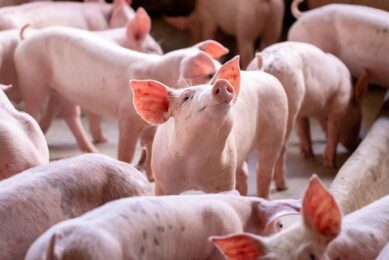Finding the sick pig in just over a day
![An ear chipped pig eating at a sensor-equipped hopper. The sensor is the circular device surrounding the hopper, just above the pig s head. <br />[Photo: Jarissa Maselyne]](https://www.pigprogress.net/app/uploads/2021/04/001_500_rb-image-2794641-848x565.jpeg)
[Photo: Jarissa Maselyne]
Especially in larger pig units, a pig with a health problem may be easily overlooked. Yet data can reveal what the eye cannot see. A Belgian study focused on how to turn no-shows at a feeder or drinker into warning signs.
Finisher pig 137 isn’t having his best day today. As soon as the sun was up, his leg started feeling sore. It happens sometimes that he has to endure a scratch or a bump. But today, it’s different. The leg really hurts. There’s no way he can walk, let alone run. “Forget that meal,” he thinks, “I’m going to skip it. Maybe tomorrow I will feel better.”
In conventional systems, pig 137 might have gone unnoticed by many pig farmers for quite a few days. The animal might indeed have felt better the next day. Yet it is equally imaginable that he simply withered away; the producer only having spotted the animal when he was lying quietly in a corner, weighing substantially less than his pen mates. In the system designed by Jarissa Maselyne, PhD, it is quite likely that pig 137 would have been noticed the very next day – and could have received the right treatment to ensure a further, healthy life. Maselyne obtained her PhD in February 2016 from the KU Leuven, Belgium, in cooperation with the Flemish Institute for Agricultural and Fisheries Research (ILVO), also in Belgium. Her thesis revolved around the automatic monitoring of the eating and drinking patterns of finishers.
Precision Livestock Farming
This research is the latest step in the ongoing search to make the world of sensors and algorithms work logically for animal husbandry. The approach used is known as Precision Livestock Farming (PLF). In the past, this approach has led to innovations such as the Cough Monitor (manufactured and marketed by Soundtalks), which registers coughs and sounds an alert when they sound like a health problem.
Key to Jarissa Maselyne’s thesis was the development of a model which can send out warnings about a pig based on its individual drinking and eating behaviour. Her model was based on a high frequency Radio Frequency Identification (RFID) system. During 5 finishing rounds, involving a total of 1,000 finishers, each pig received an ear tag with a unique number. In each round, the trials involved 4 groups, each with between 35 to 59 pigs.
Maselyne’s approach was to gather as much data as possible from these pigs’ visits to the drinker and feeder, i.e. the number of visits, the duration and time. Simultaneously, she observed what was happening. In this way, a correlation could be established between the data and what was happening in reality. For instance, the actual time spent feeding and drinking was closely compared with the RFID measurements registered. Also, after some fine-tuning of the system, the amount of water consumed proved to correlate with the time spent at the drinker. Fine-tuning was needed because sometimes very short signals, or very long ones, were sent through when a pig happened to be close to the drinker without actually drinking. A method had to be developed to take out these incorrect registrations. Converting the data into practical use was the next step. In total, 4 warning systems for the feeding pattern were developed and tested during 1 finishing round.
In these tests, key variables were:
- the number of registrations at the feeder and
- the time between feeding visits.
To better interpret these variables, Maselyne introduced the concept of ‘Synergistic Control’ (SGC) limits. These are control limits that enable a farmer to discern normal variations in an animal’s feeding and drinking behaviour from abnormal, disease-related behaviour. During the observations, pigs were found to be rather inconsistent in their eating behaviour. Pigs differed from each other, but were also observed to change their feeding pattern from day to day.
Maselyne: “For each variable, fixed limits that were constant for all the pigs throughout the fattening period were compared with SGC limits that were individual and time-varying. The concept of Synergistic Control allows you to differentiate between normal variations in the pigs’ feeding and drinking behaviour, such as age effects, and abnormal variations that signal problems. Because every fattening pig serves as its own reference and the limits are pig-specific when using SGC, possible problems can be identified at an individual level.”
Examples of messages that are sent to pig producers by the warning system. (click on the information icons)

The best system had 96.5% accuracy
All 4 warning systems were designed to give a so-called ‘attention’ signal when a pig transgressed a certain value. These signals were then compared with what was happening in practice. Through extensive observation, it could be established whether an attention signal made sense or not. Conversely, observation also revealed when no signal was given despite there being something definitely wrong. When health problems were picked up, there was no a single problem that stood out. As often happens, the pigs could have more than one health issue. Maselyne tells Pig Progress that, among pigs detected with health problems, frequent issues included lameness, reduced growth, infections, respiratory problems or fever.
Of the 4 tested warning systems, the best performing one turned out to be the one that combined Synergistic Control limits with the number of RFID registrations and used historical data to initialise the warning system. In total, using performance measures mathematically formulated, the system had a sensitivity of 66.1%, a specificity of 98.2%, accuracy of 96.5% and precision of 67.4% for all health, welfare and productivity problems spotted by the observers. Specificity refers to the percentage of healthy pig days that were identified correctly by the warning system; accuracy is the percentage of pig days that were identified correctly by the system, i.e. healthy or non-healthy. In addition, roughly two-thirds of all problems were detected (sensitivity), and also two-thirds of all attention signals sent actually made sense (precision). Before the system can be used in practice, the sensitivity and the precision could be given more attention in future research, Maselyne suggests. This can be done by further investigating how the feeding and drinking patterns change when problems occur, e.g. will a pig first reduce the time spent feeding, have fewer visits or, instead, come to feed at night? Or will it be a combination of the 3? Optimal combinations of variables in the feeding and drinking pattern and different types of warning systems can then lead to improved detection results.
Last but not least: what factual result did the best warning system give? It took the system an average of 82.1 days to report its first ‘false’ alert for individual pigs. In addition, severe problems were detected after 1.1 day on average. In other words: it would take a little more than 24 hours before pig 137 was brought to the farm manager’s attention.
* With approval, this article has been written on the basis of material from the PhD study ‘Automated monitoring of feeding and drinking patterns in growing-finishing pigs’, by Jarissa Maselyne, KU Leuven, Belgium.











